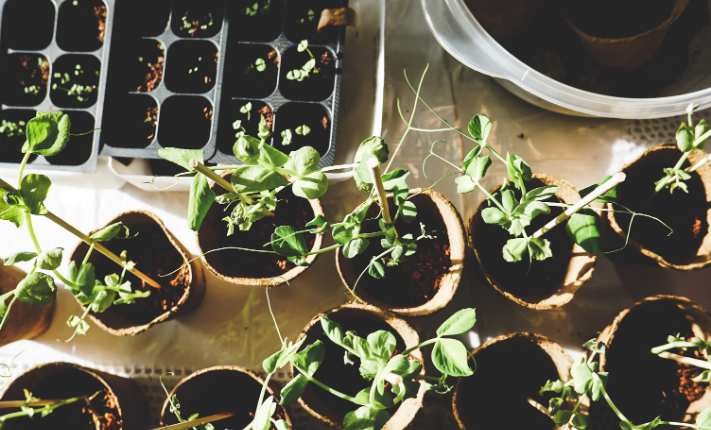Posted by Riley Fenoglio ● April, 2021
Tips and Tools For Planning Your Garden

Spring is just around the corner, and if you haven’t already, it’s time to start planning your spring or summer garden! Whether you are a beginner gardener or have been gardening for years, having a plan for your garden is essential for achieving the garden of your dreams. Setting aside some time to think about your gardening goals and putting a plan into place will get you excited about your garden and on the right track to getting started when the time comes. We’ve put together some tips and tools to help you in your planning process.
KNOW YOUR GOALS
Creating goals for your garden is a great place to start, so you can know exactly what you would like to accomplish in the upcoming growing season. Maybe you are hoping to try a new fruit or veggie this year or get a second harvest of your favorite plants. Once you know what some of your bigger goals are, you can start to break them down into smaller pieces that are easier to accomplish. Whatever your goals may be, it’s important to have them and write them down in a place where you can revisit them later to check if you’re on the right track. One good place to keep them might be in the front or back of your planting calendar, which we’ll get to later.
KNOW YOUR TIMELINE
Now that you’ve got your goals laid out and broken down, it’s time to turn them into a workable timeline. There are some things to keep in mind when making your timeline, like knowing the frost dates for your area. Frost dates are the first and last day of each spring and fall season that will be cold enough to lightly freeze, potentially harming any plants you may have already put in the ground. Frost dates can be found through a number of online planting calendars, or you can stay old school and use the Old Farmer’s Almanac. Keep in mind that frost dates are just estimates and not exact dates, so plan with some extra time or have a plan to cover your plants in case of unexpected frosts.
MONITOR YOUR SPECIFIC WEATHER
The best way to make sure you’re getting the most accurate information on when to plant in your area is by monitoring your weather with a personal weather station. A personal weather station, or PWS, will allow you to get pin-pointed information to your garden or yard, and could save you from potential early planning among other hazards. Take this example from the manager of the New York Botanical Gardens, who nearly lost a bundle of violas to an unexpected frost after his area predicted frost date.
The Tempest Personal Weather System is a great PWS for gardeners, and will bring your garden to the next level with other benefits like UV measurements to ensure best plant placement, wind data and high wind alerts, and rain measurements like accumulation, intensity, and length of rain shower. Tempest is also equipped with machine learning technology that will adjust to your specific conditions, ensuring you get the most accurate readings to your area each and every time.
GET A LIST GROWING (SEE WHAT WE DID THERE?)
You’ve got your frost dates laid out, now comes some of the fun! Deciding what to plant ahead of time will be helpful in creating a planning calendar for your garden and will be helpful in other planning processes, like mapping out your garden or beds.Suppose you’re new to planting and don’t know what to plant or what grows well in your area. In that case, there are plenty of resources to help you get started, like plant guides and plant databases that contain information about choosing, planting, and maintaining a variety of flowers, vegetables, herbs, and more. Once you’ve narrowed down your list, you can start researching dates specific to your area for when to start, transfer, or harvest the plants from your list and add them into that gardening calendar we keep mentioning.
CREATE A PLANTING CALENDAR
And here it is! After you’ve selected your crops, the final step is creating a planting calendar. This will be a great way to keep track of when you need to start or transfer your seeds, when to add fertilizer, or when to harvest. Some seeds like to begin their lives indoors while others are able go directly into the soil, which is something to be accounted for when starting your plants and something to note in your calendar. You can also use your calendar to track information like changes in growth, watering, or even weather data that may affect your garden like temperature, rain, or UV measurements. You can use a template for your gardening calendar or create something custom that works for you.
GET GROWING!
Now that you’ve researched and planned your garden, it’s time to get growing! If it’s still too early in the year to start, there are still plenty of things you can do to prep for your planting season, like checking over your equipment or doing an inventory of your tools and other necessities.You can also add specific tasks to your calendar to help prepare, like setting aside a day to clean up your flower beds or dust off any hoses or other seasonal materials that may have been kept away for the winter.
Having a plan and calendar for your garden will help keep you motivated and on the right track as you prepare for and maintain your garden throughout the season. Staying organized with your gardening means you get more time to enjoy your garden and less time working in it! We hope you use some of the tips and resources above when planning out your spring or summer garden. Happy planning!
Back to: Articles


